Reflective Log: Healthcare Engineering & Facilities Service Delivery
VerifiedAdded on 2022/12/14
|9
|2698
|485
Report
AI Summary
This report presents a reflective log on healthcare engineering and facilities service delivery, focusing on practical observations within the NHS. The log analyzes change management strategies, including reducing time spent searching for items, replacing outdated technologies, and improving the triage process. It also examines the importance of network connectivity and streamlining equipment checklists. The student identifies areas for improvement, such as financial planning for technology upgrades and the need for efficient resource allocation. The log integrates academic concepts and theories with real-world examples to demonstrate the link between practice and theory, offering insights into enhancing service delivery and patient care within the healthcare setting. The author highlights the importance of effective communication, decision-making, and financial management in driving positive changes and improving overall healthcare services. The report also considers the risks and opportunities associated with these changes, particularly in the context of network connectivity and equipment management, and proposes solutions for better healthcare outcomes.
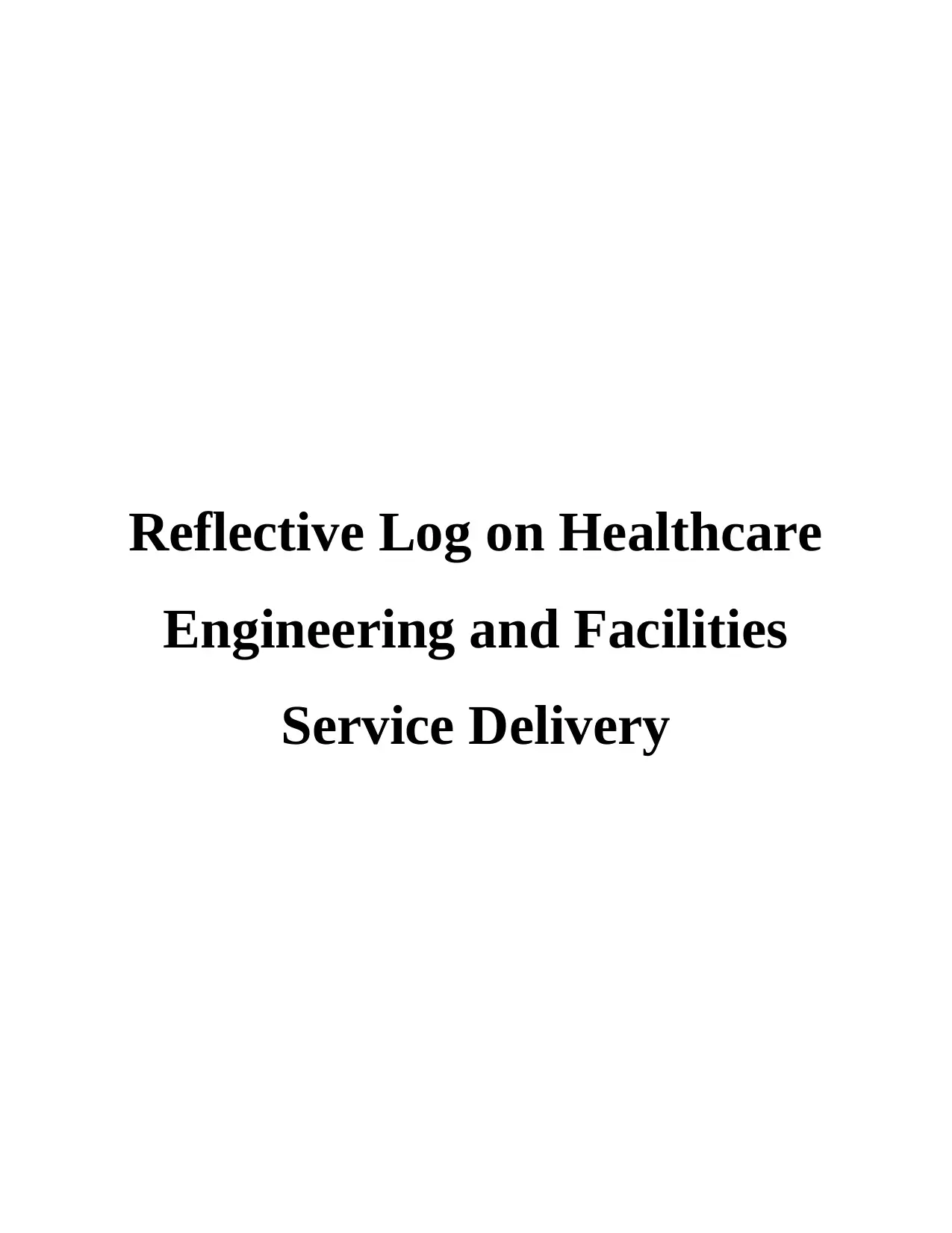
Reflective Log on Healthcare
Engineering and Facilities
Service Delivery
Engineering and Facilities
Service Delivery
Paraphrase This Document
Need a fresh take? Get an instant paraphrase of this document with our AI Paraphraser
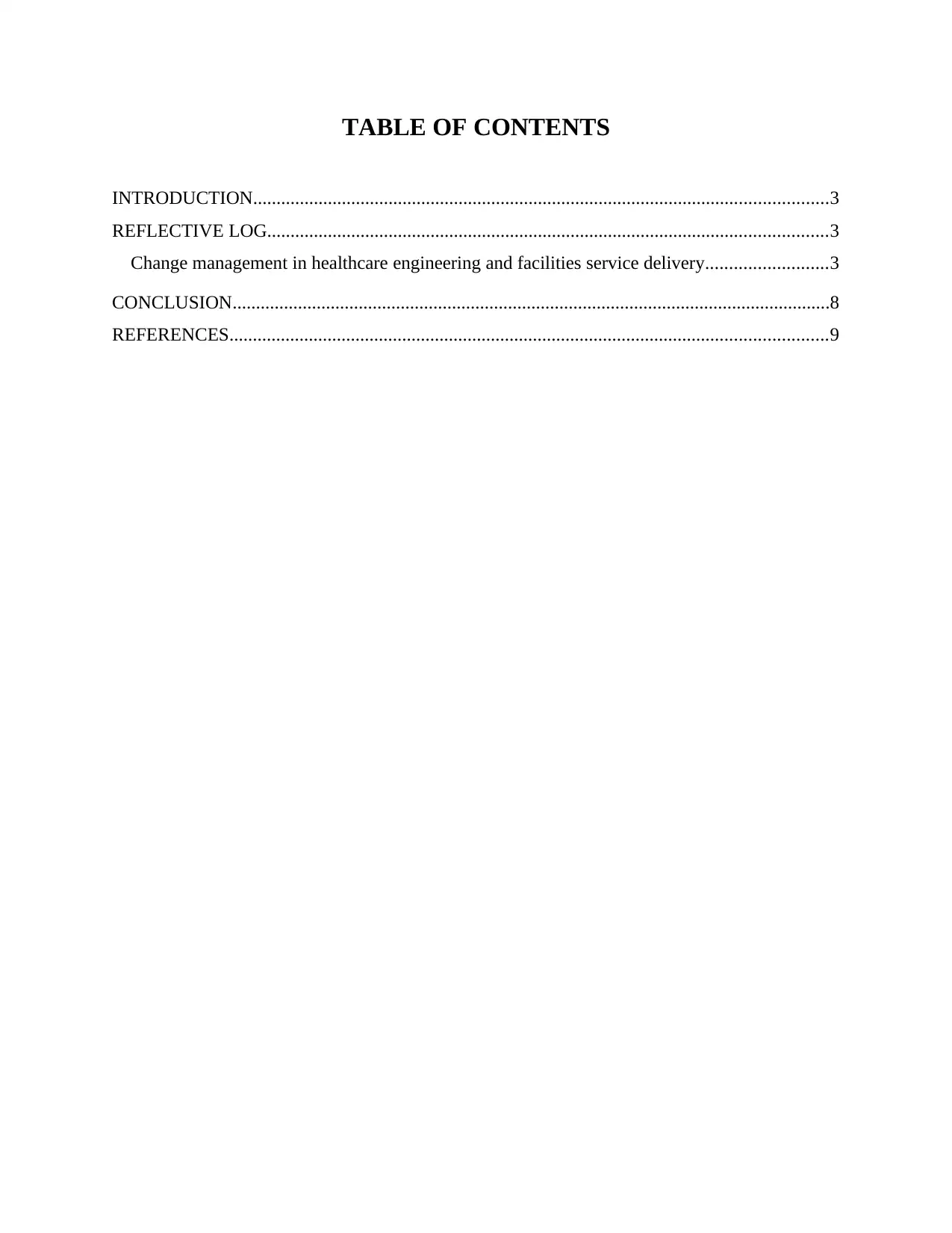
TABLE OF CONTENTS
INTRODUCTION...........................................................................................................................3
REFLECTIVE LOG........................................................................................................................3
Change management in healthcare engineering and facilities service delivery..........................3
CONCLUSION................................................................................................................................8
REFERENCES................................................................................................................................9
INTRODUCTION...........................................................................................................................3
REFLECTIVE LOG........................................................................................................................3
Change management in healthcare engineering and facilities service delivery..........................3
CONCLUSION................................................................................................................................8
REFERENCES................................................................................................................................9
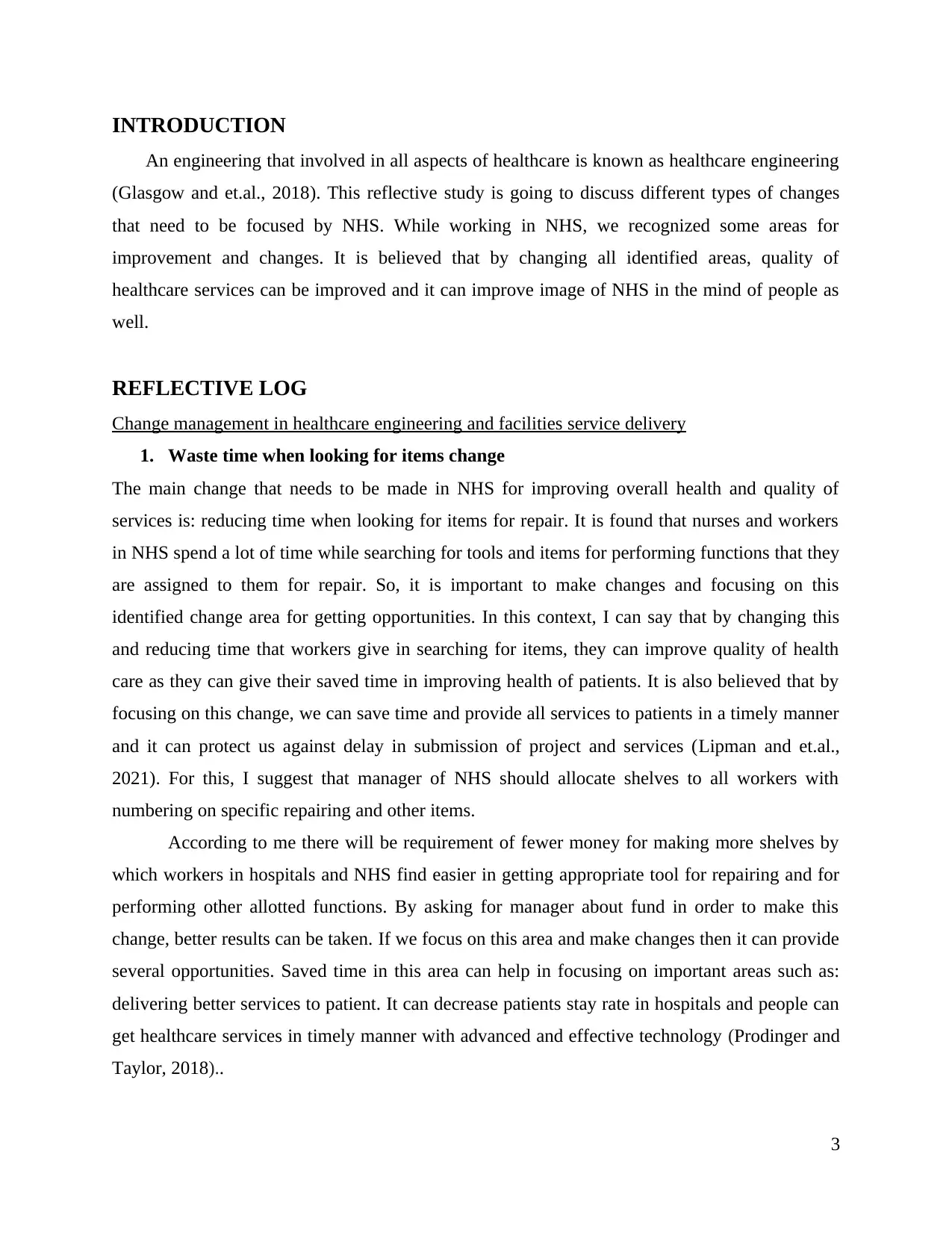
INTRODUCTION
An engineering that involved in all aspects of healthcare is known as healthcare engineering
(Glasgow and et.al., 2018). This reflective study is going to discuss different types of changes
that need to be focused by NHS. While working in NHS, we recognized some areas for
improvement and changes. It is believed that by changing all identified areas, quality of
healthcare services can be improved and it can improve image of NHS in the mind of people as
well.
REFLECTIVE LOG
Change management in healthcare engineering and facilities service delivery
1. Waste time when looking for items change
The main change that needs to be made in NHS for improving overall health and quality of
services is: reducing time when looking for items for repair. It is found that nurses and workers
in NHS spend a lot of time while searching for tools and items for performing functions that they
are assigned to them for repair. So, it is important to make changes and focusing on this
identified change area for getting opportunities. In this context, I can say that by changing this
and reducing time that workers give in searching for items, they can improve quality of health
care as they can give their saved time in improving health of patients. It is also believed that by
focusing on this change, we can save time and provide all services to patients in a timely manner
and it can protect us against delay in submission of project and services (Lipman and et.al.,
2021). For this, I suggest that manager of NHS should allocate shelves to all workers with
numbering on specific repairing and other items.
According to me there will be requirement of fewer money for making more shelves by
which workers in hospitals and NHS find easier in getting appropriate tool for repairing and for
performing other allotted functions. By asking for manager about fund in order to make this
change, better results can be taken. If we focus on this area and make changes then it can provide
several opportunities. Saved time in this area can help in focusing on important areas such as:
delivering better services to patient. It can decrease patients stay rate in hospitals and people can
get healthcare services in timely manner with advanced and effective technology (Prodinger and
Taylor, 2018)..
3
An engineering that involved in all aspects of healthcare is known as healthcare engineering
(Glasgow and et.al., 2018). This reflective study is going to discuss different types of changes
that need to be focused by NHS. While working in NHS, we recognized some areas for
improvement and changes. It is believed that by changing all identified areas, quality of
healthcare services can be improved and it can improve image of NHS in the mind of people as
well.
REFLECTIVE LOG
Change management in healthcare engineering and facilities service delivery
1. Waste time when looking for items change
The main change that needs to be made in NHS for improving overall health and quality of
services is: reducing time when looking for items for repair. It is found that nurses and workers
in NHS spend a lot of time while searching for tools and items for performing functions that they
are assigned to them for repair. So, it is important to make changes and focusing on this
identified change area for getting opportunities. In this context, I can say that by changing this
and reducing time that workers give in searching for items, they can improve quality of health
care as they can give their saved time in improving health of patients. It is also believed that by
focusing on this change, we can save time and provide all services to patients in a timely manner
and it can protect us against delay in submission of project and services (Lipman and et.al.,
2021). For this, I suggest that manager of NHS should allocate shelves to all workers with
numbering on specific repairing and other items.
According to me there will be requirement of fewer money for making more shelves by
which workers in hospitals and NHS find easier in getting appropriate tool for repairing and for
performing other allotted functions. By asking for manager about fund in order to make this
change, better results can be taken. If we focus on this area and make changes then it can provide
several opportunities. Saved time in this area can help in focusing on important areas such as:
delivering better services to patient. It can decrease patients stay rate in hospitals and people can
get healthcare services in timely manner with advanced and effective technology (Prodinger and
Taylor, 2018)..
3
⊘ This is a preview!⊘
Do you want full access?
Subscribe today to unlock all pages.

Trusted by 1+ million students worldwide
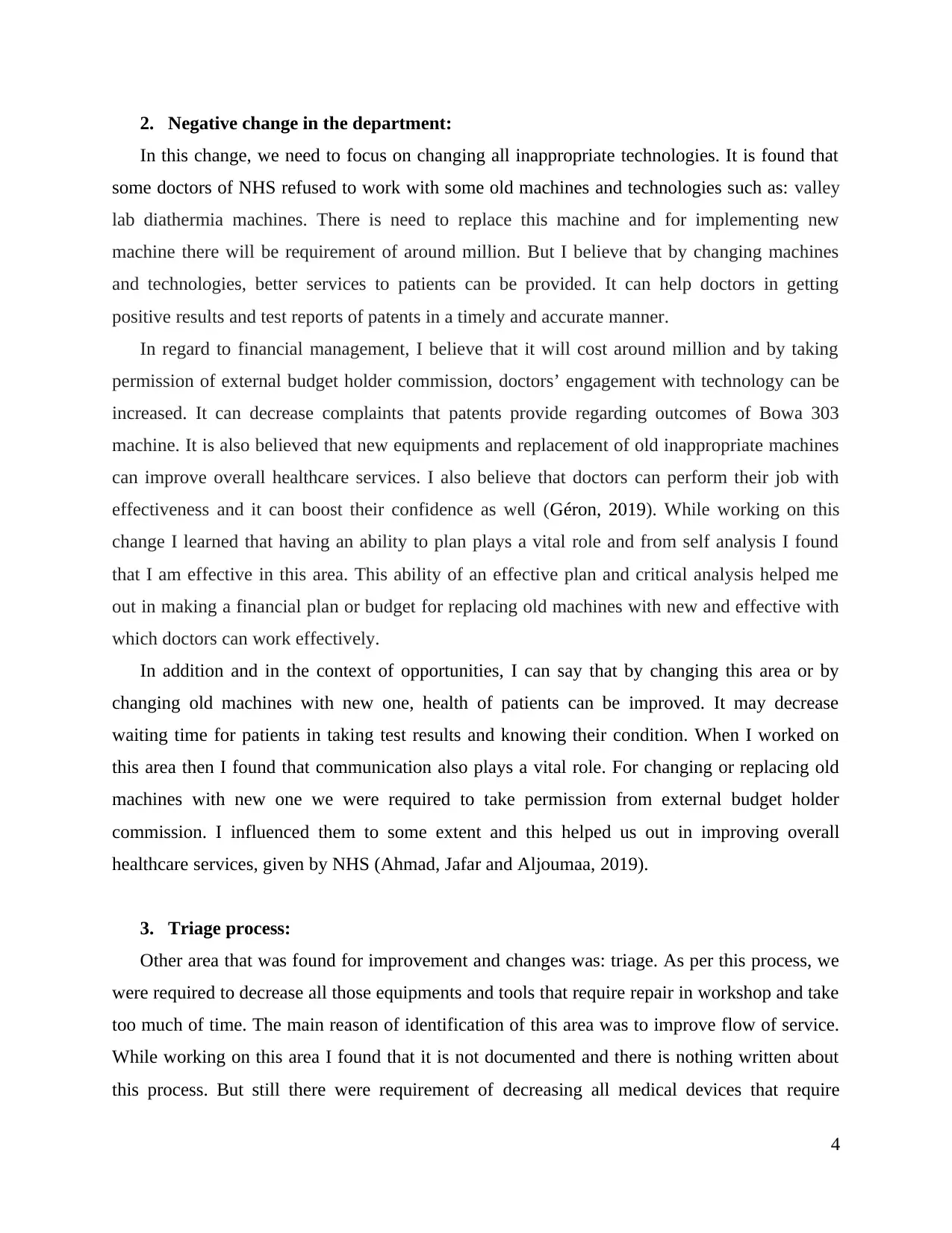
2. Negative change in the department:
In this change, we need to focus on changing all inappropriate technologies. It is found that
some doctors of NHS refused to work with some old machines and technologies such as: valley
lab diathermia machines. There is need to replace this machine and for implementing new
machine there will be requirement of around million. But I believe that by changing machines
and technologies, better services to patients can be provided. It can help doctors in getting
positive results and test reports of patents in a timely and accurate manner.
In regard to financial management, I believe that it will cost around million and by taking
permission of external budget holder commission, doctors’ engagement with technology can be
increased. It can decrease complaints that patents provide regarding outcomes of Bowa 303
machine. It is also believed that new equipments and replacement of old inappropriate machines
can improve overall healthcare services. I also believe that doctors can perform their job with
effectiveness and it can boost their confidence as well (Géron, 2019). While working on this
change I learned that having an ability to plan plays a vital role and from self analysis I found
that I am effective in this area. This ability of an effective plan and critical analysis helped me
out in making a financial plan or budget for replacing old machines with new and effective with
which doctors can work effectively.
In addition and in the context of opportunities, I can say that by changing this area or by
changing old machines with new one, health of patients can be improved. It may decrease
waiting time for patients in taking test results and knowing their condition. When I worked on
this area then I found that communication also plays a vital role. For changing or replacing old
machines with new one we were required to take permission from external budget holder
commission. I influenced them to some extent and this helped us out in improving overall
healthcare services, given by NHS (Ahmad, Jafar and Aljoumaa, 2019).
3. Triage process:
Other area that was found for improvement and changes was: triage. As per this process, we
were required to decrease all those equipments and tools that require repair in workshop and take
too much of time. The main reason of identification of this area was to improve flow of service.
While working on this area I found that it is not documented and there is nothing written about
this process. But still there were requirement of decreasing all medical devices that require
4
In this change, we need to focus on changing all inappropriate technologies. It is found that
some doctors of NHS refused to work with some old machines and technologies such as: valley
lab diathermia machines. There is need to replace this machine and for implementing new
machine there will be requirement of around million. But I believe that by changing machines
and technologies, better services to patients can be provided. It can help doctors in getting
positive results and test reports of patents in a timely and accurate manner.
In regard to financial management, I believe that it will cost around million and by taking
permission of external budget holder commission, doctors’ engagement with technology can be
increased. It can decrease complaints that patents provide regarding outcomes of Bowa 303
machine. It is also believed that new equipments and replacement of old inappropriate machines
can improve overall healthcare services. I also believe that doctors can perform their job with
effectiveness and it can boost their confidence as well (Géron, 2019). While working on this
change I learned that having an ability to plan plays a vital role and from self analysis I found
that I am effective in this area. This ability of an effective plan and critical analysis helped me
out in making a financial plan or budget for replacing old machines with new and effective with
which doctors can work effectively.
In addition and in the context of opportunities, I can say that by changing this area or by
changing old machines with new one, health of patients can be improved. It may decrease
waiting time for patients in taking test results and knowing their condition. When I worked on
this area then I found that communication also plays a vital role. For changing or replacing old
machines with new one we were required to take permission from external budget holder
commission. I influenced them to some extent and this helped us out in improving overall
healthcare services, given by NHS (Ahmad, Jafar and Aljoumaa, 2019).
3. Triage process:
Other area that was found for improvement and changes was: triage. As per this process, we
were required to decrease all those equipments and tools that require repair in workshop and take
too much of time. The main reason of identification of this area was to improve flow of service.
While working on this area I found that it is not documented and there is nothing written about
this process. But still there were requirement of decreasing all medical devices that require
4
Paraphrase This Document
Need a fresh take? Get an instant paraphrase of this document with our AI Paraphraser
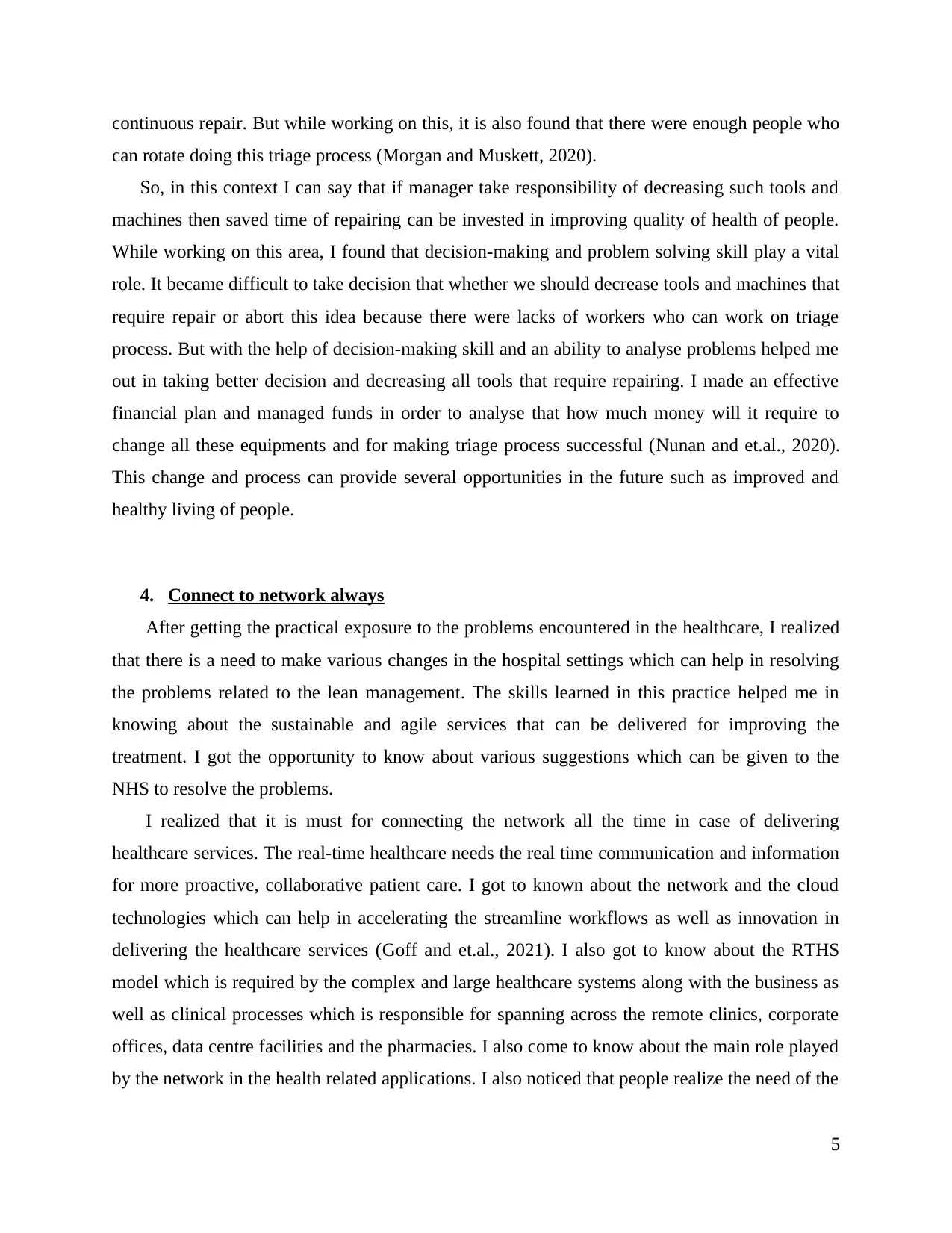
continuous repair. But while working on this, it is also found that there were enough people who
can rotate doing this triage process (Morgan and Muskett, 2020).
So, in this context I can say that if manager take responsibility of decreasing such tools and
machines then saved time of repairing can be invested in improving quality of health of people.
While working on this area, I found that decision-making and problem solving skill play a vital
role. It became difficult to take decision that whether we should decrease tools and machines that
require repair or abort this idea because there were lacks of workers who can work on triage
process. But with the help of decision-making skill and an ability to analyse problems helped me
out in taking better decision and decreasing all tools that require repairing. I made an effective
financial plan and managed funds in order to analyse that how much money will it require to
change all these equipments and for making triage process successful (Nunan and et.al., 2020).
This change and process can provide several opportunities in the future such as improved and
healthy living of people.
4. Connect to network always
After getting the practical exposure to the problems encountered in the healthcare, I realized
that there is a need to make various changes in the hospital settings which can help in resolving
the problems related to the lean management. The skills learned in this practice helped me in
knowing about the sustainable and agile services that can be delivered for improving the
treatment. I got the opportunity to know about various suggestions which can be given to the
NHS to resolve the problems.
I realized that it is must for connecting the network all the time in case of delivering
healthcare services. The real-time healthcare needs the real time communication and information
for more proactive, collaborative patient care. I got to known about the network and the cloud
technologies which can help in accelerating the streamline workflows as well as innovation in
delivering the healthcare services (Goff and et.al., 2021). I also got to know about the RTHS
model which is required by the complex and large healthcare systems along with the business as
well as clinical processes which is responsible for spanning across the remote clinics, corporate
offices, data centre facilities and the pharmacies. I also come to know about the main role played
by the network in the health related applications. I also noticed that people realize the need of the
5
can rotate doing this triage process (Morgan and Muskett, 2020).
So, in this context I can say that if manager take responsibility of decreasing such tools and
machines then saved time of repairing can be invested in improving quality of health of people.
While working on this area, I found that decision-making and problem solving skill play a vital
role. It became difficult to take decision that whether we should decrease tools and machines that
require repair or abort this idea because there were lacks of workers who can work on triage
process. But with the help of decision-making skill and an ability to analyse problems helped me
out in taking better decision and decreasing all tools that require repairing. I made an effective
financial plan and managed funds in order to analyse that how much money will it require to
change all these equipments and for making triage process successful (Nunan and et.al., 2020).
This change and process can provide several opportunities in the future such as improved and
healthy living of people.
4. Connect to network always
After getting the practical exposure to the problems encountered in the healthcare, I realized
that there is a need to make various changes in the hospital settings which can help in resolving
the problems related to the lean management. The skills learned in this practice helped me in
knowing about the sustainable and agile services that can be delivered for improving the
treatment. I got the opportunity to know about various suggestions which can be given to the
NHS to resolve the problems.
I realized that it is must for connecting the network all the time in case of delivering
healthcare services. The real-time healthcare needs the real time communication and information
for more proactive, collaborative patient care. I got to known about the network and the cloud
technologies which can help in accelerating the streamline workflows as well as innovation in
delivering the healthcare services (Goff and et.al., 2021). I also got to know about the RTHS
model which is required by the complex and large healthcare systems along with the business as
well as clinical processes which is responsible for spanning across the remote clinics, corporate
offices, data centre facilities and the pharmacies. I also come to know about the main role played
by the network in the health related applications. I also noticed that people realize the need of the
5
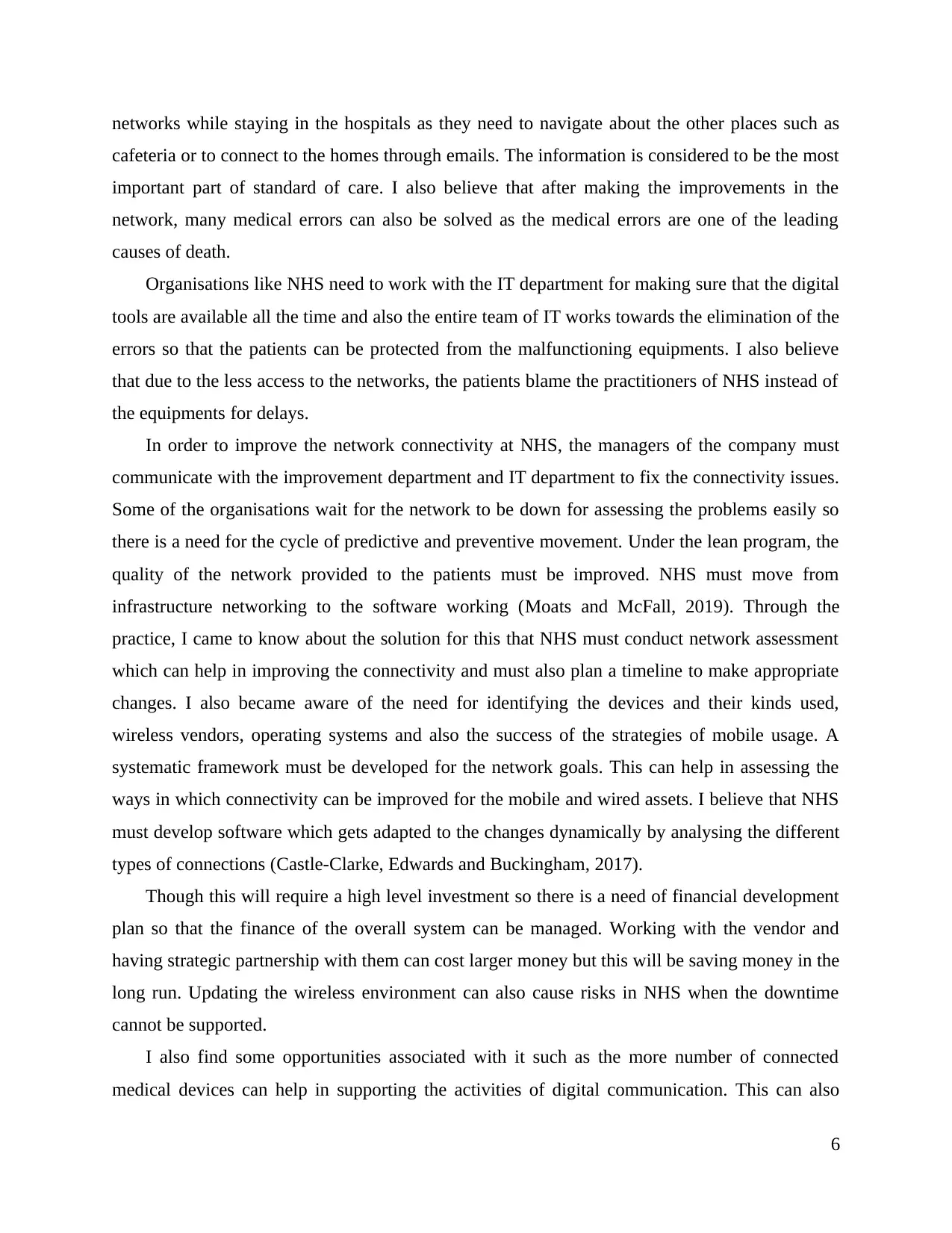
networks while staying in the hospitals as they need to navigate about the other places such as
cafeteria or to connect to the homes through emails. The information is considered to be the most
important part of standard of care. I also believe that after making the improvements in the
network, many medical errors can also be solved as the medical errors are one of the leading
causes of death.
Organisations like NHS need to work with the IT department for making sure that the digital
tools are available all the time and also the entire team of IT works towards the elimination of the
errors so that the patients can be protected from the malfunctioning equipments. I also believe
that due to the less access to the networks, the patients blame the practitioners of NHS instead of
the equipments for delays.
In order to improve the network connectivity at NHS, the managers of the company must
communicate with the improvement department and IT department to fix the connectivity issues.
Some of the organisations wait for the network to be down for assessing the problems easily so
there is a need for the cycle of predictive and preventive movement. Under the lean program, the
quality of the network provided to the patients must be improved. NHS must move from
infrastructure networking to the software working (Moats and McFall, 2019). Through the
practice, I came to know about the solution for this that NHS must conduct network assessment
which can help in improving the connectivity and must also plan a timeline to make appropriate
changes. I also became aware of the need for identifying the devices and their kinds used,
wireless vendors, operating systems and also the success of the strategies of mobile usage. A
systematic framework must be developed for the network goals. This can help in assessing the
ways in which connectivity can be improved for the mobile and wired assets. I believe that NHS
must develop software which gets adapted to the changes dynamically by analysing the different
types of connections (Castle-Clarke, Edwards and Buckingham, 2017).
Though this will require a high level investment so there is a need of financial development
plan so that the finance of the overall system can be managed. Working with the vendor and
having strategic partnership with them can cost larger money but this will be saving money in the
long run. Updating the wireless environment can also cause risks in NHS when the downtime
cannot be supported.
I also find some opportunities associated with it such as the more number of connected
medical devices can help in supporting the activities of digital communication. This can also
6
cafeteria or to connect to the homes through emails. The information is considered to be the most
important part of standard of care. I also believe that after making the improvements in the
network, many medical errors can also be solved as the medical errors are one of the leading
causes of death.
Organisations like NHS need to work with the IT department for making sure that the digital
tools are available all the time and also the entire team of IT works towards the elimination of the
errors so that the patients can be protected from the malfunctioning equipments. I also believe
that due to the less access to the networks, the patients blame the practitioners of NHS instead of
the equipments for delays.
In order to improve the network connectivity at NHS, the managers of the company must
communicate with the improvement department and IT department to fix the connectivity issues.
Some of the organisations wait for the network to be down for assessing the problems easily so
there is a need for the cycle of predictive and preventive movement. Under the lean program, the
quality of the network provided to the patients must be improved. NHS must move from
infrastructure networking to the software working (Moats and McFall, 2019). Through the
practice, I came to know about the solution for this that NHS must conduct network assessment
which can help in improving the connectivity and must also plan a timeline to make appropriate
changes. I also became aware of the need for identifying the devices and their kinds used,
wireless vendors, operating systems and also the success of the strategies of mobile usage. A
systematic framework must be developed for the network goals. This can help in assessing the
ways in which connectivity can be improved for the mobile and wired assets. I believe that NHS
must develop software which gets adapted to the changes dynamically by analysing the different
types of connections (Castle-Clarke, Edwards and Buckingham, 2017).
Though this will require a high level investment so there is a need of financial development
plan so that the finance of the overall system can be managed. Working with the vendor and
having strategic partnership with them can cost larger money but this will be saving money in the
long run. Updating the wireless environment can also cause risks in NHS when the downtime
cannot be supported.
I also find some opportunities associated with it such as the more number of connected
medical devices can help in supporting the activities of digital communication. This can also
6
⊘ This is a preview!⊘
Do you want full access?
Subscribe today to unlock all pages.

Trusted by 1+ million students worldwide
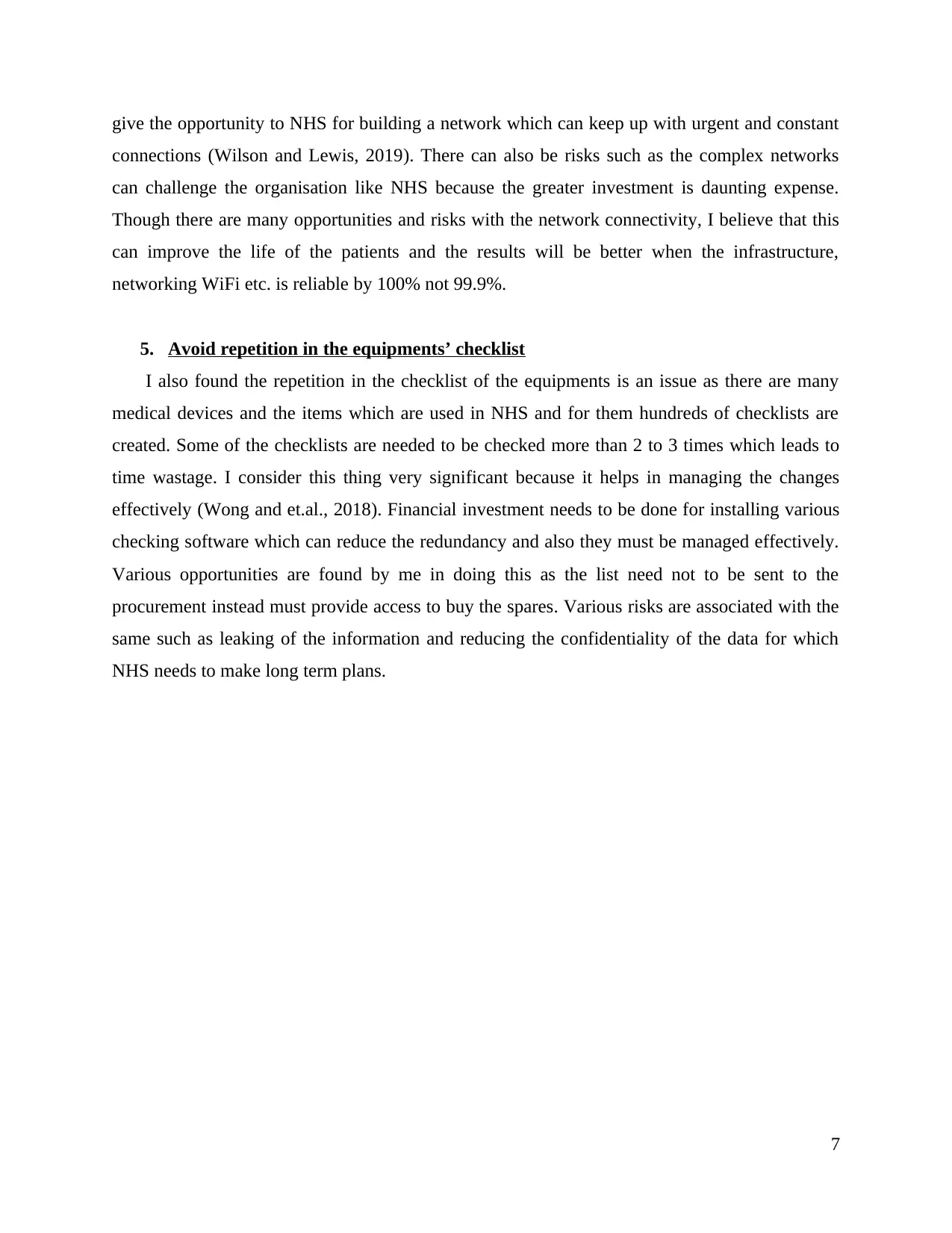
give the opportunity to NHS for building a network which can keep up with urgent and constant
connections (Wilson and Lewis, 2019). There can also be risks such as the complex networks
can challenge the organisation like NHS because the greater investment is daunting expense.
Though there are many opportunities and risks with the network connectivity, I believe that this
can improve the life of the patients and the results will be better when the infrastructure,
networking WiFi etc. is reliable by 100% not 99.9%.
5. Avoid repetition in the equipments’ checklist
I also found the repetition in the checklist of the equipments is an issue as there are many
medical devices and the items which are used in NHS and for them hundreds of checklists are
created. Some of the checklists are needed to be checked more than 2 to 3 times which leads to
time wastage. I consider this thing very significant because it helps in managing the changes
effectively (Wong and et.al., 2018). Financial investment needs to be done for installing various
checking software which can reduce the redundancy and also they must be managed effectively.
Various opportunities are found by me in doing this as the list need not to be sent to the
procurement instead must provide access to buy the spares. Various risks are associated with the
same such as leaking of the information and reducing the confidentiality of the data for which
NHS needs to make long term plans.
7
connections (Wilson and Lewis, 2019). There can also be risks such as the complex networks
can challenge the organisation like NHS because the greater investment is daunting expense.
Though there are many opportunities and risks with the network connectivity, I believe that this
can improve the life of the patients and the results will be better when the infrastructure,
networking WiFi etc. is reliable by 100% not 99.9%.
5. Avoid repetition in the equipments’ checklist
I also found the repetition in the checklist of the equipments is an issue as there are many
medical devices and the items which are used in NHS and for them hundreds of checklists are
created. Some of the checklists are needed to be checked more than 2 to 3 times which leads to
time wastage. I consider this thing very significant because it helps in managing the changes
effectively (Wong and et.al., 2018). Financial investment needs to be done for installing various
checking software which can reduce the redundancy and also they must be managed effectively.
Various opportunities are found by me in doing this as the list need not to be sent to the
procurement instead must provide access to buy the spares. Various risks are associated with the
same such as leaking of the information and reducing the confidentiality of the data for which
NHS needs to make long term plans.
7
Paraphrase This Document
Need a fresh take? Get an instant paraphrase of this document with our AI Paraphraser
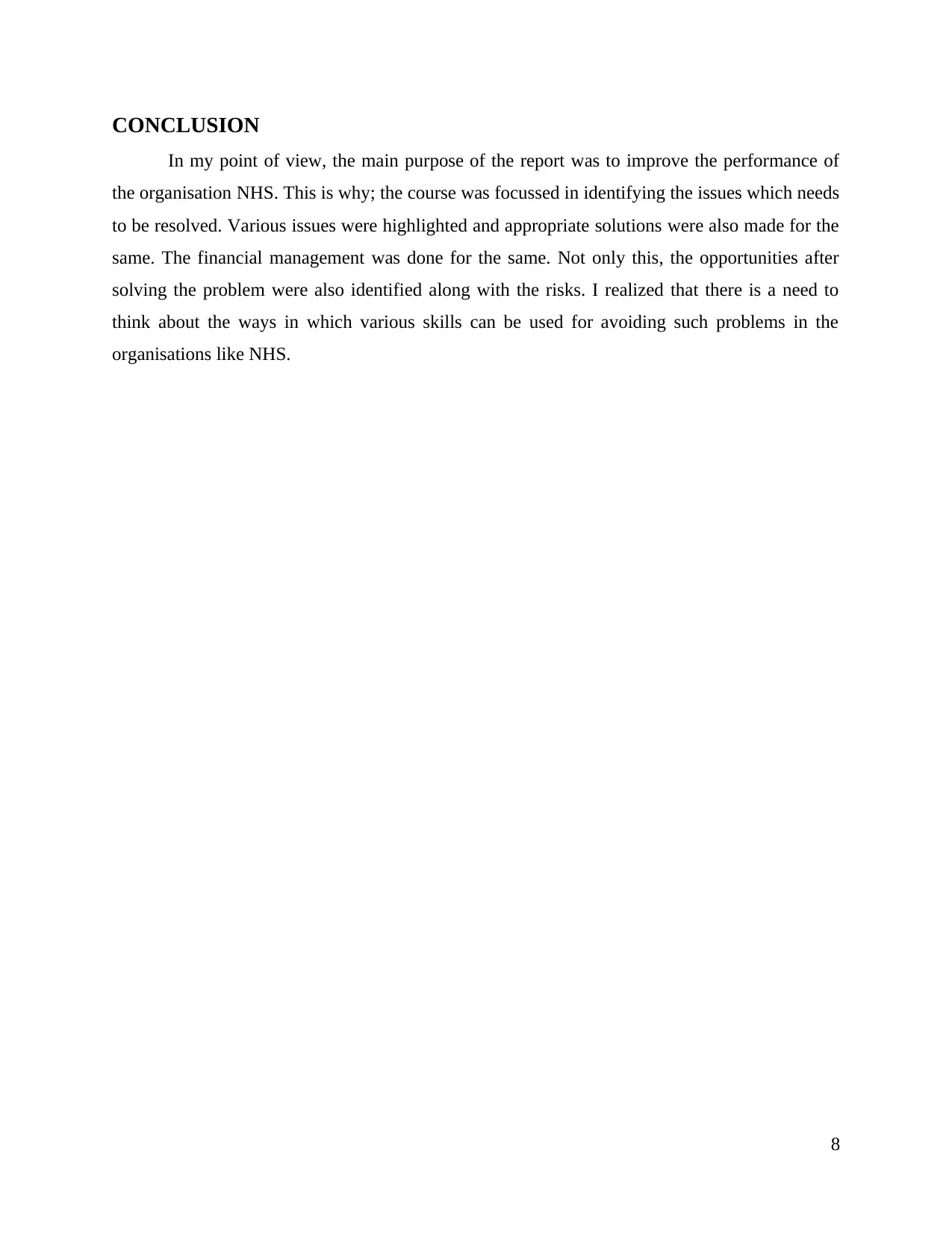
CONCLUSION
In my point of view, the main purpose of the report was to improve the performance of
the organisation NHS. This is why; the course was focussed in identifying the issues which needs
to be resolved. Various issues were highlighted and appropriate solutions were also made for the
same. The financial management was done for the same. Not only this, the opportunities after
solving the problem were also identified along with the risks. I realized that there is a need to
think about the ways in which various skills can be used for avoiding such problems in the
organisations like NHS.
8
In my point of view, the main purpose of the report was to improve the performance of
the organisation NHS. This is why; the course was focussed in identifying the issues which needs
to be resolved. Various issues were highlighted and appropriate solutions were also made for the
same. The financial management was done for the same. Not only this, the opportunities after
solving the problem were also identified along with the risks. I realized that there is a need to
think about the ways in which various skills can be used for avoiding such problems in the
organisations like NHS.
8
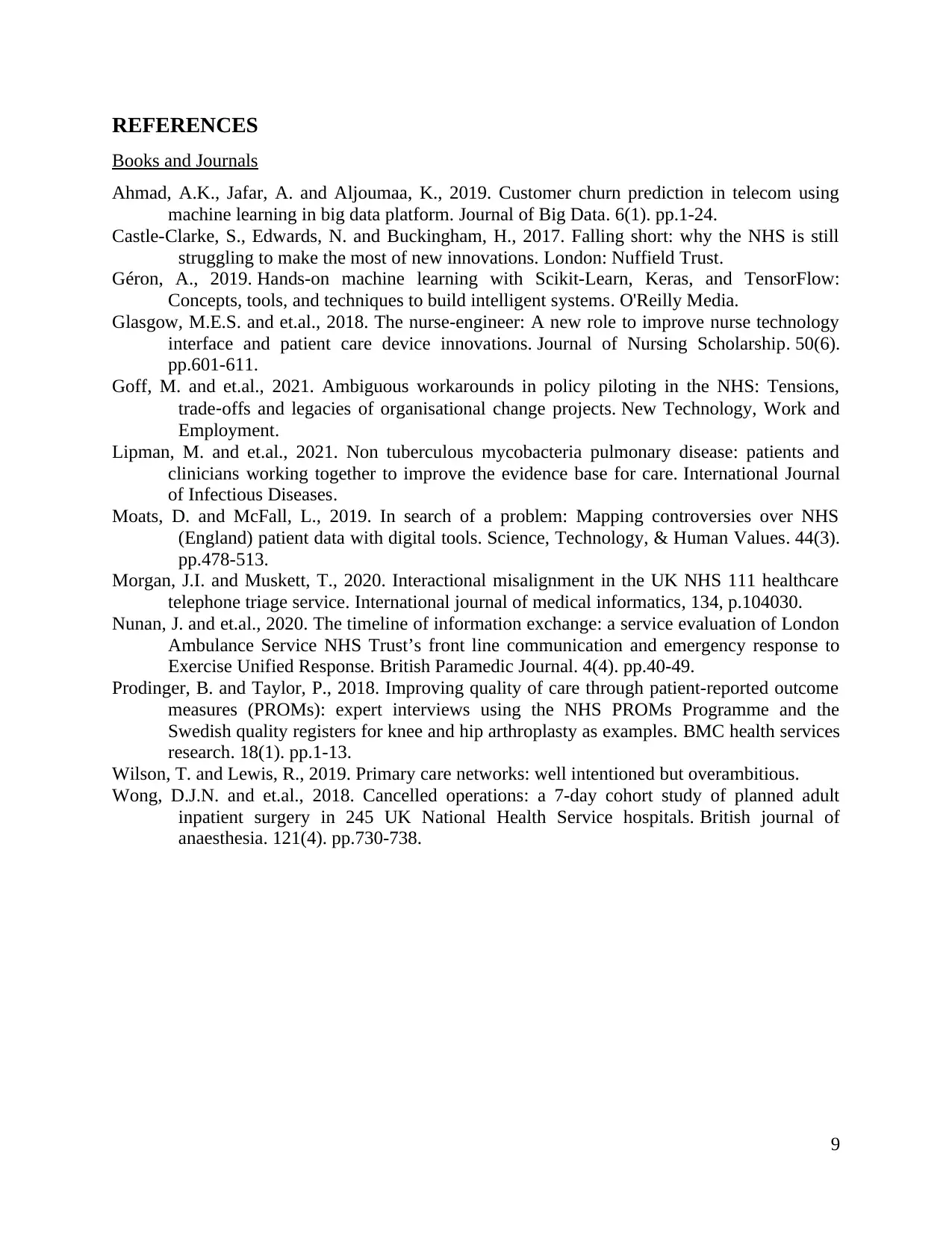
REFERENCES
Books and Journals
Ahmad, A.K., Jafar, A. and Aljoumaa, K., 2019. Customer churn prediction in telecom using
machine learning in big data platform. Journal of Big Data. 6(1). pp.1-24.
Castle-Clarke, S., Edwards, N. and Buckingham, H., 2017. Falling short: why the NHS is still
struggling to make the most of new innovations. London: Nuffield Trust.
Géron, A., 2019. Hands-on machine learning with Scikit-Learn, Keras, and TensorFlow:
Concepts, tools, and techniques to build intelligent systems. O'Reilly Media.
Glasgow, M.E.S. and et.al., 2018. The nurse‐engineer: A new role to improve nurse technology
interface and patient care device innovations. Journal of Nursing Scholarship. 50(6).
pp.601-611.
Goff, M. and et.al., 2021. Ambiguous workarounds in policy piloting in the NHS: Tensions,
trade‐offs and legacies of organisational change projects. New Technology, Work and
Employment.
Lipman, M. and et.al., 2021. Non tuberculous mycobacteria pulmonary disease: patients and
clinicians working together to improve the evidence base for care. International Journal
of Infectious Diseases.
Moats, D. and McFall, L., 2019. In search of a problem: Mapping controversies over NHS
(England) patient data with digital tools. Science, Technology, & Human Values. 44(3).
pp.478-513.
Morgan, J.I. and Muskett, T., 2020. Interactional misalignment in the UK NHS 111 healthcare
telephone triage service. International journal of medical informatics, 134, p.104030.
Nunan, J. and et.al., 2020. The timeline of information exchange: a service evaluation of London
Ambulance Service NHS Trust’s front line communication and emergency response to
Exercise Unified Response. British Paramedic Journal. 4(4). pp.40-49.
Prodinger, B. and Taylor, P., 2018. Improving quality of care through patient-reported outcome
measures (PROMs): expert interviews using the NHS PROMs Programme and the
Swedish quality registers for knee and hip arthroplasty as examples. BMC health services
research. 18(1). pp.1-13.
Wilson, T. and Lewis, R., 2019. Primary care networks: well intentioned but overambitious.
Wong, D.J.N. and et.al., 2018. Cancelled operations: a 7-day cohort study of planned adult
inpatient surgery in 245 UK National Health Service hospitals. British journal of
anaesthesia. 121(4). pp.730-738.
9
Books and Journals
Ahmad, A.K., Jafar, A. and Aljoumaa, K., 2019. Customer churn prediction in telecom using
machine learning in big data platform. Journal of Big Data. 6(1). pp.1-24.
Castle-Clarke, S., Edwards, N. and Buckingham, H., 2017. Falling short: why the NHS is still
struggling to make the most of new innovations. London: Nuffield Trust.
Géron, A., 2019. Hands-on machine learning with Scikit-Learn, Keras, and TensorFlow:
Concepts, tools, and techniques to build intelligent systems. O'Reilly Media.
Glasgow, M.E.S. and et.al., 2018. The nurse‐engineer: A new role to improve nurse technology
interface and patient care device innovations. Journal of Nursing Scholarship. 50(6).
pp.601-611.
Goff, M. and et.al., 2021. Ambiguous workarounds in policy piloting in the NHS: Tensions,
trade‐offs and legacies of organisational change projects. New Technology, Work and
Employment.
Lipman, M. and et.al., 2021. Non tuberculous mycobacteria pulmonary disease: patients and
clinicians working together to improve the evidence base for care. International Journal
of Infectious Diseases.
Moats, D. and McFall, L., 2019. In search of a problem: Mapping controversies over NHS
(England) patient data with digital tools. Science, Technology, & Human Values. 44(3).
pp.478-513.
Morgan, J.I. and Muskett, T., 2020. Interactional misalignment in the UK NHS 111 healthcare
telephone triage service. International journal of medical informatics, 134, p.104030.
Nunan, J. and et.al., 2020. The timeline of information exchange: a service evaluation of London
Ambulance Service NHS Trust’s front line communication and emergency response to
Exercise Unified Response. British Paramedic Journal. 4(4). pp.40-49.
Prodinger, B. and Taylor, P., 2018. Improving quality of care through patient-reported outcome
measures (PROMs): expert interviews using the NHS PROMs Programme and the
Swedish quality registers for knee and hip arthroplasty as examples. BMC health services
research. 18(1). pp.1-13.
Wilson, T. and Lewis, R., 2019. Primary care networks: well intentioned but overambitious.
Wong, D.J.N. and et.al., 2018. Cancelled operations: a 7-day cohort study of planned adult
inpatient surgery in 245 UK National Health Service hospitals. British journal of
anaesthesia. 121(4). pp.730-738.
9
⊘ This is a preview!⊘
Do you want full access?
Subscribe today to unlock all pages.

Trusted by 1+ million students worldwide
1 out of 9
Related Documents
Your All-in-One AI-Powered Toolkit for Academic Success.
+13062052269
info@desklib.com
Available 24*7 on WhatsApp / Email
![[object Object]](/_next/static/media/star-bottom.7253800d.svg)
Unlock your academic potential
Copyright © 2020–2025 A2Z Services. All Rights Reserved. Developed and managed by ZUCOL.





